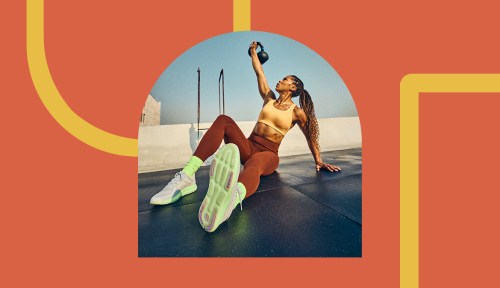Our editors independently select these products. Making a purchase through our links may earn Well+Good a commission
Once you know your way around a gym, it’s relatively simple to start a new strength-training routine. What’s harder? Sticking with it.
Experts in This Article
“Something I love to speak to my clients about is that this is a lifestyle, and it takes a long time to see those gains,” says Kayla Jeter, a certified functional strength coach who’s a brand ambassador for both Lululemon and Garmin. “Consistency over intensity is the name of the game for sure.”
Jeter started strength training when she was 12 years old, when she first grew serious about volleyball (she later went on to play for the University of Tennessee and then professionally), and the time she’s put in at the gym over the years has taught her a lot about what truly helps you see results—and what doesn’t.
Her 7 strength-training strategies that work
Jeter gave us the rundown on the top strength-training strategies that work for her, including her favorite exercises, her go-to gear, and the mantra she lives by.
1. Before jumping in, she warms up any muscles she’ll be using
Like any good coach, Jeter underscores the need to “wake up and warm up your body, especially your core and nervous system” before any workout. She sees this time as a way to activate and prime her muscles, while also improving tissue length and density in the process. Her favorite way to do all that is through foam rolling, using mini bands, and doing dynamic mobility exercises like thread the needle or cat-cow.
Get ready for your workout with one of Jeter’s fave mobility exercises:
2. She sticks with what works
Rather than climbing on every last fitness trend train, Jeter prioritizes exercises that she knows will pay off. “When I think about the movements that I go back to time and time again, week after week, month after month, year after year, it is really the same non-sexy stuff,” she says. That means squats for strong quads, calf raises to help her running technique, and single leg step-ups for motor control and stability.
3. She treats her feet as her foundation
When we’re focused on the bigger muscles in our bodies—the abs, the glutes, the biceps—it’s easy to forget about all the little ones we’re standing on. But the feet are the base of any standing movements, so if they’re not anchoring us properly, it can cause issues all the way up the chain.
Before she starts any movement, Jeter makes sure her feet are bracing the ground like a tripod: “So the heel, big toe, and pinky toe are planted into the ground to really support the body,” she says. This helps provide stability and prevent injury.
4. She makes sure her core is firing
Although you’ll often hear trainers tell you to “activate your core,” that cue is meaningless unless you know how to do it. So Jeter gets a little more specific. “Two things I tell people to think about is: If someone were to punch you in the stomach—you would brace, right? And as soon as you pull your ribcage down toward your hip bones, you create this wrap around from your belly button to the sides to your back,” she says.
Jeter focuses on those two cues—while also allowing enough space to breathe in 360 degrees—to help protect her spine in any exercises she’s doing.
5. She wears the gear that serves her—and revs her up
As a Lululemon ambassador, Jeter swears by the brand’s Strongfeel training shoes ($128). “When you’re strength training, you wanna feel supported,” she says. “And as a person who does dynamic movements in the gym, in these shoes I feel like I can change a direction, I can do a step-up, I can sprint and still feel supported and have a distraction-free experience.”
She also suggests wearing your “super suit” any time you’re working out. For her, that’s an all-black outfit, maybe with a pop of color in her shoes. (Fave pieces include Lululemon’s Wunder Train tights because of their high waist, and the Find Your Pace shorts with their breezy, flowy, sexy cut.) “If I’m wearing all black at the gym, business is about to go down,” she says, with a laugh. But this isn’t just about the fun of dressing up—you want to wear something that will make you feel confident and competent, that brings out the strongest version of you.
Lululemon Strongfeel Training Shoe — $128.00
6. She’s working on prioritizing sleep
We’re all a working on something, and for Jeter that’s getting more sleep. Although she’s long been able to operate off of just five and a half hours per night, she’s striving to get more like seven hours these days. Because she knows that, for any of her other strength-training strategies to work, she needs a solid foundation of rest. “You can only train to the capacity at which you’ve recovered,” she says.
Research shows that one third of Americans don’t get enough sleep. But Jeter knows the value of solid shuteye. “It’s where your brain takes out the trash, it’s where muscles are repaired, it’s where you’re just rejuvenated and refreshed,” she says.
7. She aims for improvement, not perfection
Jeter’s dad was a professional football player, and he always told her to strive to do her best—knowing that what “your best” is changes from day to day. Now, Jeter lives by the mantra of aiming to be one percent better every day. “It means one percent more effort, more focus, more intention than the day before,” she says. “If the one percent’s just laying down, you know, starfish on the mat, then hey, we got better.”
Sign Up for Our Daily Newsletter
Get all the latest in wellness, trends, food, fitness, beauty, and more delivered right to your inbox.
Got it, you've been added to our email list.












